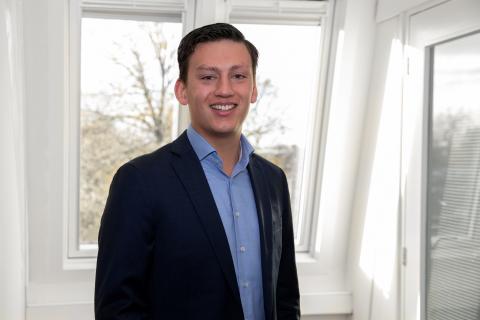
This time in our "In the spotlight": Bram de la Combé; since 2019 he's found the perfect combination of data and logistics at the Solutions department of Districon. In this edition he would like to tell more about the things that drives his enthusiasm.
Who are you?
Often I ask myself “How will we transport ourselves or our freight in the near future?”. This question does not exist without a reason. As a child, I had the habit to want to know everything about cars, trucks and motorcycles. Actually, every machine is interesting to me.
I think I can say that I saw many tv shows like “Wheeler dealers” and that I spend many evenings trying to improve and fix my old motorcycle. Nevertheless, it’s good to look forward. Currently, we are at the start of an energy transition and certain habits must change. How are we going to deliver our warehouses if trucks aren’t going to run on fossil fuels? Or that it's not going to happen in the near future, and, will it be more effective to analyze our current COշ emissions? Let us first start with the saying “to measure to know”.
With this in mind, I worked on BigMile, which is the tool for shippers and carriers to analyze and improve their COշ emissions. One of the challenges is to develop a tool that is user friendly, but at the same time capable of coping with many different logistic profiles of users.
Only analyzing the current situation does not lower a COշ emission, processes need to change and need to be optimized. Usually, process optimization leads to lower costs. For me, it is also about dealing with valuable resources. For example, the increase of data availability for a parcel delivery company has led to a higher success ratio of first-time delivery. This is one of the projects I am glad that additionally COշ emissions were lowered.
Vision for the future?
Back to my question at the start, how will we transport ourselves or our freight in the near future. In order to answer that, I once built an electric powered vehicle. The main goal was to run as efficient as possible with the energy carrier, hydrogen gas. Looking at another energy carrier, I also got familiar with the production process of lithium batteries in China. This gave me a good perspective on the development of hydrogen fuel cell powered vehicles (FCEV) versus battery powered vehicles (BEV).
Eventually, I think that there will be a mix between both energy carriers, but we must make sure that we always do our best to move ourselves and our freight as efficient as possible. To summarize, this is all about combining data and logistics. Which are the two things I get enthusiastic about, so I look forward to the future.
Which colleague will be in the spotlight next?
Diego works across the ocean. Currently there are lot of things happing over there, but what drives Diego? I assume that it has something to do with the search for the best possible solution for every mathematical problem. More about that during the next edition of “In the spotlight”!
